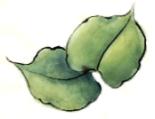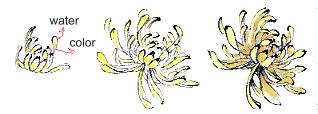Draw the contour of object in light ink first. Apply color washes within the contour. Mix up color with water in the saucer and stir with the brush. Color or water may be added to attain the right shade.
One application may different from the other in color and shade according to the subject you paint.



2 Wet underpainting, layers of color, rubbings in color
Wet underpainting is applied when ink-drawing is dry. Wet the paper first with water. In most cases this is done bigger areas such as water and sky. Absorb excess moisture from the painting paper with another piece of absorbent paper. Apply color on the wet-underpainting. Use another clean brush to smooth the painting strokes if required.

A picture can be painted with a few layers of color. Second layer of color may be applied to a color-underpainting which is dry. Still another layer may be added if you see fit. Wonderful color effect may be attained in this way.

Rubbing is done with a dry brush using the brush-side technique. It is best used for description of feathers.

3 Color mixing
Two or three colors can be mixed together to produce another tint. It is common knowledge that Gamboge and Indigo make green, Crimson Lake and Indigo make purple.......
To mix colors, stir well two or three colors in a saucer with water. In many cases it is more desirable to let two or three colors blend naturally on the paper. It is also common practice in Chinese painting, however, to acheive well blended colors in one single stroke by soaking different colors in succession with the brush.
First soak the brush with one color and then with
another.
For example, soak the brush with diluted Gamboge
first and then dip the brush into Vermilion; first with indigo and
then with ink; or first with Vermilion and then Crimson Lake.
To paint a petal in this method, the brush is first soaked with White and
then dip the tip of the brush into Crimson Lake or other color. The colors
so painted will look fresh and delightful.



4 Color harmony
All the colors in a painting must be brought into a harmonious state. Therefore, one or two colors must be dominating while other colors are subordinate. Either make the dominating colors striking, or if they be subtle colors, let them color bigger space in the picture composition.
Colors, like ink, may be applied dry or wet, in
one single layer or in a few layers, to produce different effects.
